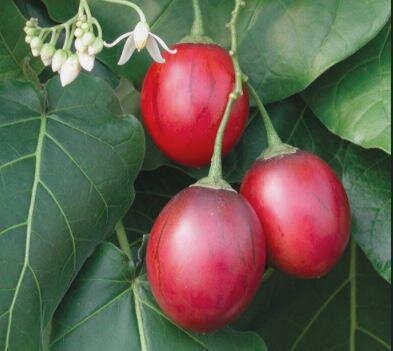 Image 1 of 2
Image 1 of 2

 Image 2 of 2
Image 2 of 2

Tamarillo
Tamarillo also called the tomato of the tree, tamarillos originated in South America. It is a cross between passion fruits and tomato. The colour varies from yellow/orange to red or almost purple: The fruits lighter in colour are sweeter. Tamarillos are excellent for making chutney, sauce, relish and jelly because of the pectin they contain. They also have a substantial amount of dietary fibre while providing decent amounts of mineral salts, potassium, iron, vitamins A, C, E and pro-vitamin A, along with antioxidants.
The chlorogenic acid found in tamarillos a polyphenol ( also found in coffee and black tea), has potential antioxidant and chemopreventive activities; Chlorogenic acid scavenges free radicals, which inhibits DNA damage and may protect against the induction of carcinogenesis (carcinogenesis or oncogenesis is the process by which normal, healthy cells are transformed into cancer cells).
Available from July until November
Tamarillo also called the tomato of the tree, tamarillos originated in South America. It is a cross between passion fruits and tomato. The colour varies from yellow/orange to red or almost purple: The fruits lighter in colour are sweeter. Tamarillos are excellent for making chutney, sauce, relish and jelly because of the pectin they contain. They also have a substantial amount of dietary fibre while providing decent amounts of mineral salts, potassium, iron, vitamins A, C, E and pro-vitamin A, along with antioxidants.
The chlorogenic acid found in tamarillos a polyphenol ( also found in coffee and black tea), has potential antioxidant and chemopreventive activities; Chlorogenic acid scavenges free radicals, which inhibits DNA damage and may protect against the induction of carcinogenesis (carcinogenesis or oncogenesis is the process by which normal, healthy cells are transformed into cancer cells).
Available from July until November
Tamarillo also called the tomato of the tree, tamarillos originated in South America. It is a cross between passion fruits and tomato. The colour varies from yellow/orange to red or almost purple: The fruits lighter in colour are sweeter. Tamarillos are excellent for making chutney, sauce, relish and jelly because of the pectin they contain. They also have a substantial amount of dietary fibre while providing decent amounts of mineral salts, potassium, iron, vitamins A, C, E and pro-vitamin A, along with antioxidants.
The chlorogenic acid found in tamarillos a polyphenol ( also found in coffee and black tea), has potential antioxidant and chemopreventive activities; Chlorogenic acid scavenges free radicals, which inhibits DNA damage and may protect against the induction of carcinogenesis (carcinogenesis or oncogenesis is the process by which normal, healthy cells are transformed into cancer cells).
Available from July until November

Cooking tips
Cut the tamarillo in half, sprinkle the tamarillo with sugar, then eat directly out of the peel with a spoon. Don't eat the peel as it is bitter.
